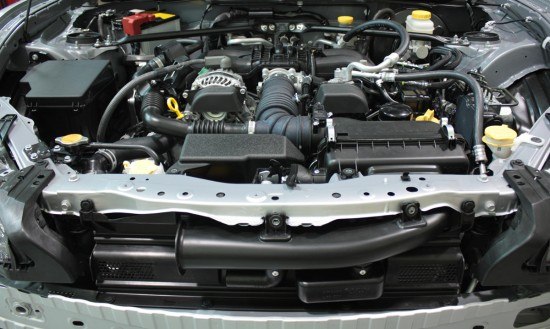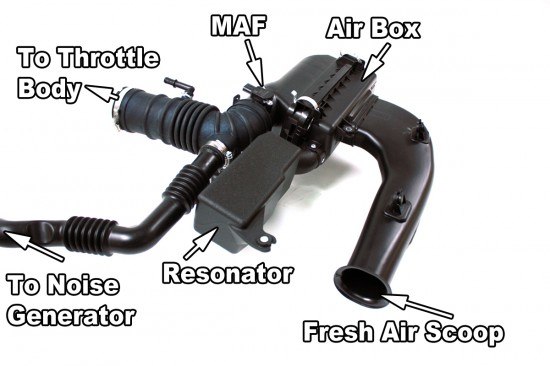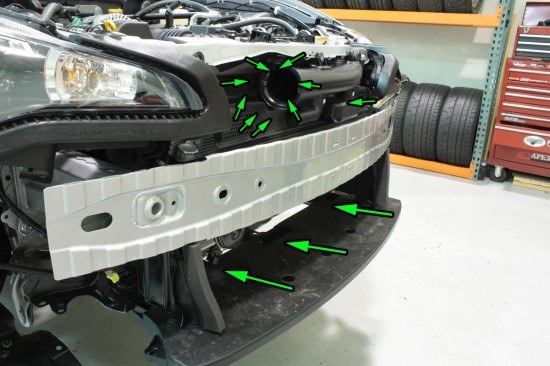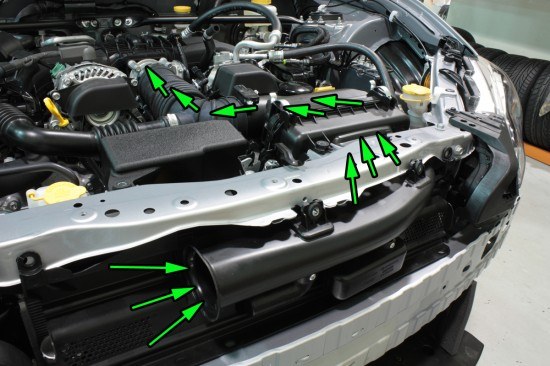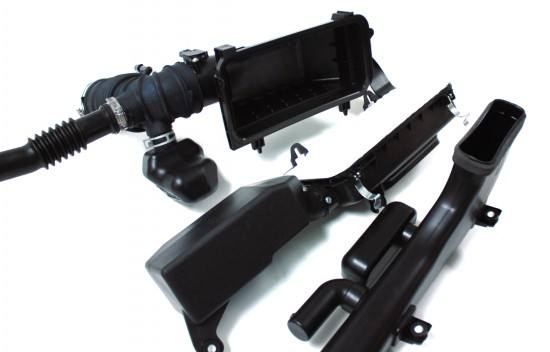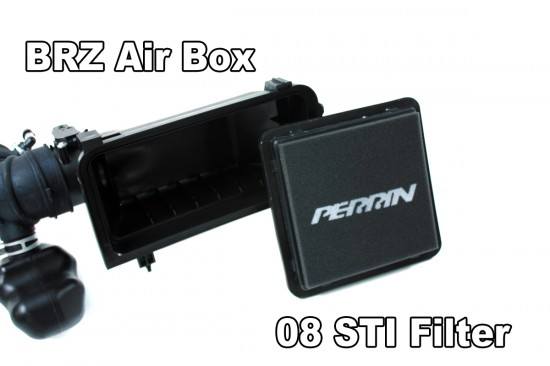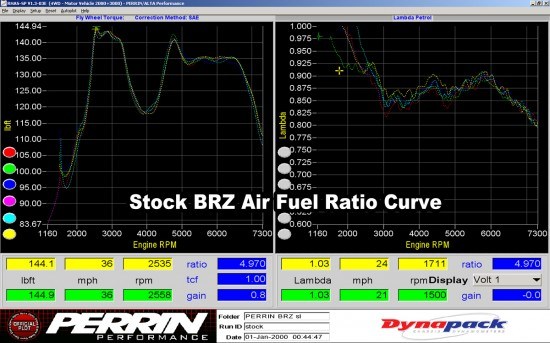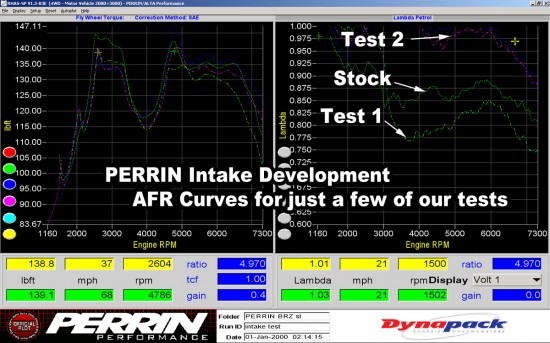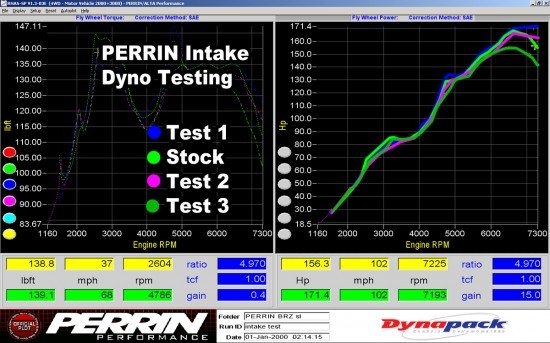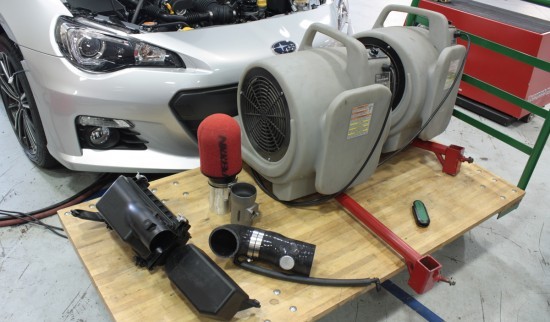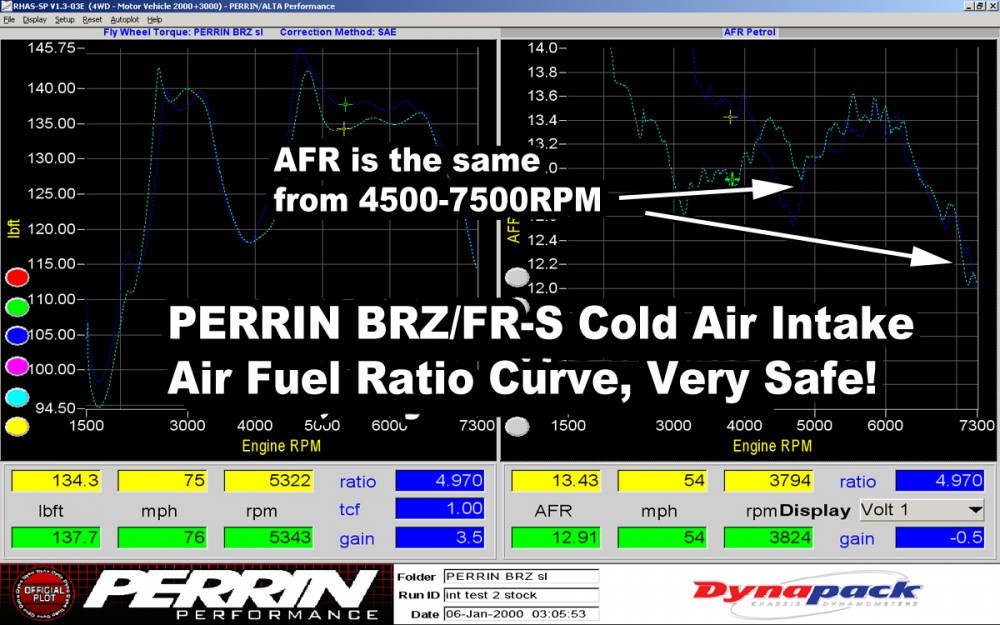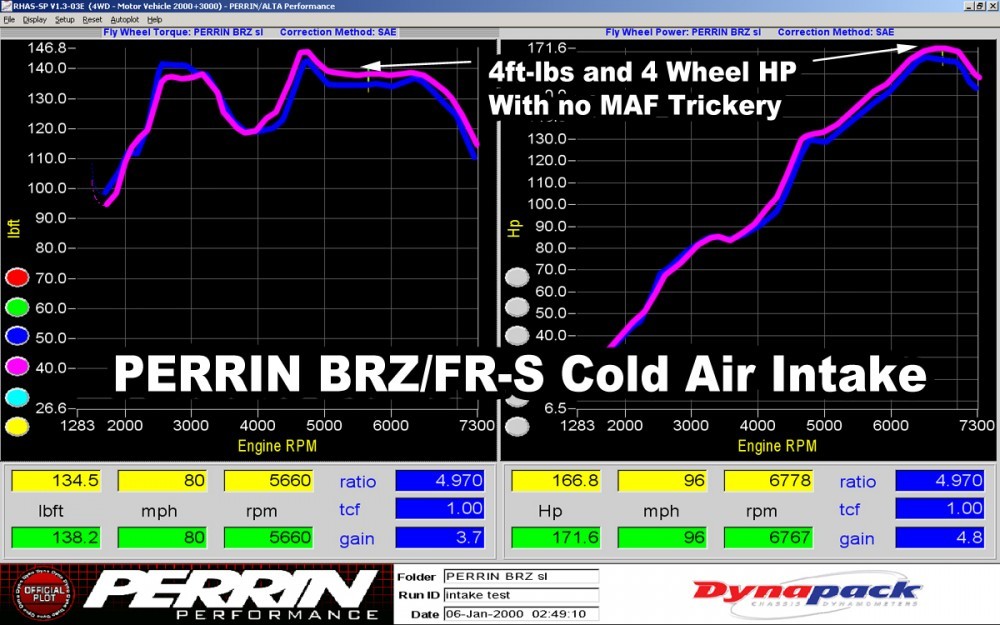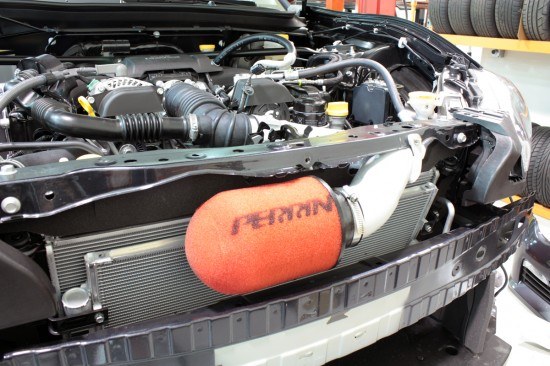Share This
In our world, intakes are not all created equal. Intakes generally require an ECU retune to compensate for the change in airflow readings. This is because intake manufacturers can use a variety of different style MAF flanges, tubing sizes, and even bends before and after the MAF sensor can all create different readings for the ECU. These readings can affect how the car runs in all conditions, but most importantly under full throttle. An intake can cause a dangerously lean condition under full throttle, which can lead to engine damage or worse yet a catastrophic failure.
These are all key factors in how we design an intake for the BRZ/FR-S. On the dyno we had prepared a few different intake styles as well as a special adjustable MAF housing to help determine what is the best size tubing, routing and design for this new car. In the end what we came up with will suit all types of customers and tuners.
First lets look at the stock intake system. You can see that from under the hood there is an air box and a hose that goes to the throttle body. Also visible are the resonating chambers on the air box and the rubber intake hose. These are in place to quiet down the intake and are very common to find on intakes in general across all brands in the past few years. The other strange item is the long tube that goes to a round device on the intake manifold. This part is called a noise generator, and its designed to add intake and engine sound to the inside of the car. A great way to add cool sounds for the driver and yet still keep ambient volume levels down. This noise/sound generator is very common on European cars and it looks like it€™s making its way to Japanese and Domestic cars and trucks too. What you don€™t see is the part that gets air from the front bumper.
Here are a couple of diagrams showing the airflow to the intake. The bumper is removed so you can more clearly see the airflow path toward the engine. Air enters the lower portion of the bumper opening and travels behind the bumper beam. From there it goes through the radiator and also a portion goes up to the fresh air intake pipe. There is a large plastic wall installed with small holes in it, apparently to help reduce turbulent air from entering the intake.
From the fresh air pipe, it goes through the core support over the radiator, then into the air box, through the filter, then past the MAF sensor, then finally the rubber intake hose. Its a nice, short, clean path from the front of the car to the engine!
In this diagram you can see all parts of the OEM intake system. Starting in the bumper, there is the ram air looking tube (not really ram air, but fresh air) that has (2) of its own resonators on it. Then you have the air box with MAF (Mass Air Flow) sensor on it, and the rubber intake tube.
Overall the system is very short and efficient looking. The question is: Can we gain HP from installing something better? The stock filter seems kind of small. Look below to find a picture of the stock BRZ/FR-S air box next to one of our PERRIN 2008+ STI panel filters.
The OEM BRZ/FR-S air box's breathable surface area is 51.9 sq-in and the STI's air boxes breathable area is 63.9 sq-in. The picture doens't look like its any bigger, but the STI air box is bigger by almost 20%. Which makes sense as it makes more HP. This is a good sign as it could mean there is some HP to gain from replacing the stock filter with a better, higher flow filter media. More on that though in a later post.
Before we go and change a bunch of things its important to unerstand how the ECU is working and also where the flaws in the stock system are. With currently no ECU tuing available, we had to resort to some old logging tools. These provided enough info for us to at least grasp what the ECU is doing. The first dyno runs were done to establish an average HP and Air fuel ratio curve. Our goal here is to match or at least get very close to matching the stock Air fuel ratio curve or Lambda curve.
Air fuel ratio and Lambda are important things to understand. Air fuel ratio (AFR) is a ratio of how much fuel is being injected compared to how much air is being consumed. The actual number is based off of stoichiometric, which a ratio of air and fuel where all fuel is burt completly in the combustion chamber. For gasoline this number is 14.7 to 1. That means 14.7 parts air and 1 part fuel. Since stoichiometric varies with different fuels, Lambda is a different way to express this while covering all fuels. Lambda is actually more preferred by professional tuners as its a simple % of that fuels stoichiometric ratio. Lambda is expressed where stochiometric is 1.00. So no matter the fuel (Race fuels, Leaded, LPG, diesel...) 1.00 is stoichiometric. Lambda or AFR gauges are the only way to really know how your engine is running and its is what we will use to tune our intake with.
How do we match this AFR curve? As we mentioned before different size housings, bends and things can cause air turbulence and affect the readings that the MAF sensor outputs to the ECU. For instance if you install a huge diameter tube where the MAF sensor is, and the ECU sees less air flow for the same given RPM and load. This is because the air flowing through a larger tube is slower moving. This causes a lean condition and is very dangerous. Then you have the opposite problem with a smaller tube, where the air is flowing very quickly through for that same RPM and load. This causes a rich condition.
Below is just a couple of old diagrams showing examples of this, using some really basic drawings (from a yet to be published post)
You can see how making an intake, with the proper MAF housing, and tubing is very important to insure you engine is running properly and doesn€™t throw a check engine light. Sometimes tuners will install intakes that purposely mess up these readings to trick the ECU into changing the air fuel ratio. This is not a good way to make HP, because when there is ECU tuning available, it will mess up the custom tuning you paid for as well as again risk damage to your engine.
Here are a few of the many dyno runs showing different intakes we tested. Our intake testing was done on a stock 2013 BRZ. We did this to ensure there were no variables from other aftermarket parts causing flawed results.
You can see there is a run that is very lean and one that is very rich. The engine was ok with running both these tests, but not something we would be ok with giving to a customer. Too lean of a mixture, and things can heat up and melt pistons, or knock or lots of bad things. Too rich and you loose power for no reason, and fuel economy suffers.
During some of the tests we purposely changed the MAF to cause the engine to run leaner to see if we could gain HP by leaning out the Air fuel ratio above 6000. Check out the blue run! This shows that there is power to gain from tuning the air fuel ratio, and from the freer flowing intake. From 7000 to 7300, there is a solid 10 Wheel HP we gained. That is huge! Again, to be clear, this was a test, we were purposely tricking the MAF sensor to see how the engine would react to leaner Air Fuel ratio's at redline. This is not ok for us to give to a customer because a future tune may cause an extreme lean condition, leading to engine damage or even failure!
The above dyno runs were just a small amount of the things we tested. The first being no filter in the stock air box. We did this along with removing all the resonators, from the intake and the results were no gains in HP. There was nothing gained at all by removing these things other than the change to the intake sound. That tells us that the stock HP and the stock intake are a good match.
But, does this change when we can up the redline and make more HP with ECU tuning? We still plan on making a high flow/reusable foam drop in filter even if this doesn't make any HP on the stock car. We know at some point it will make more HP and it will flow more air than your dirty stock filter.
NOTE: The tests shown below do not correlate to the AFR curves we showed above.
These below tests represent one of our final intake designs. You can see how we matched the stock Air Fuel Ratio very close. This is a vital part to making an intake that does NOT require an ECU retune. This is important as it allows for more customers to buy a part that doesn't require the additional cost of an ECU retune. This is our goal with one of the two intakes we will offer.
Finally the HP results! Now this doesn't look like much, but keep in mind the stock air box with no filter made ZEROadditional HP. We created an intake that makes HP, and is safe to run on your car. This intake is still under development, and will have some minor tweaks to it to improve it prior to when it goes on sale.
We expect to do lots of re-dynoing of parts like this after we are able to tune the ECU. One reason is that we may be able to make more HP after we raise the redline a bit and make more HP.
You can see by the picture, that not everything about our new PERRIN BRZ/FR-S Intake is clear. This may be the first time we don't fully disclose something we are making, but its for a few good reasons. One is there are many variables that can effect how the intake works in the real world. This means there is still lots of testing to do, luckily we have 3 shop cars to do this with. The other reason is we wanted to keep a couple things up our sleeve when this part is released.
What we have learned is we will be offering two intakes. One that runs very close to the stock MAF curve, this will suite the more common customer that doesn't need or want a tune, but would rather get some really cool sounds along with a bit of HP. The other intake will require an ECU retune, and is designed for the customer who wants the maximum HP from his car.
We will only be offering this in a cold air type intake. The short ram intakes (filter under the hood) were ok, but the radiator blows hot air directly at the filter and eliminates all the benefits of removing the air box. With this normally aspirated engine, we need to extract the most from every part we make and a short ram intake isn't going to cut it.
You can see that we are fully dedicated to this new car. We love new challenges, we love new customers, and we love what we do. Making cars more fun (not just faster) is what we all live for! We have been doing this now for almost 11 years for Subaru, with the company dating back to 1996! This is only the beginning for this exciting new platform of performance driving!



